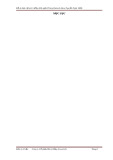
BioMed Central
Page 1 of 15
(page number not for citation purposes)
Journal of Immune Based Therapies
and Vaccines
Open Access
Original research
Human anti-anthrax protective antigen neutralizing monoclonal
antibodies derived from donors vaccinated with anthrax vaccine
adsorbed
Ritsuko Sawada-Hirai1, Ivy Jiang1, Fei Wang1, Shu Man Sun1,
Rebecca Nedellec1, Paul Ruther1, Alejandro Alvarez1,2, Diane Millis1,
Phillip R Morrow1 and Angray S Kang*1
Address: 1Avanir Pharmaceuticals Inc, Antibody Technology, 11388 Sorrento Valley Rd, San Diego, California 92121, USA and 2Current affiliation
Acadia Pharmaceuticals Inc, 3911 Sorrento Valley Rd, San Diego, California 92121, USA
Email: Ritsuko Sawada-Hirai - rswada@avanir.com; Ivy Jiang - ijiang@avanir.com; Fei Wang - fwang@avanir.com;
Shu Man Sun - ssun@avanir.com; Rebecca Nedellec - rnedellec@avanir.com; Paul Ruther - pruther@avanir.com;
Alejandro Alvarez - aalvarez@acadia-pharm.com; Diane Millis - dmillis@avanir.com; Phillip R Morrow - pmorrow@avanir.com;
Angray S Kang* - akang@avanir.com
* Corresponding author
Abstract
Background: Potent anthrax toxin neutralizing human monoclonal antibodies were generated from peripheral
blood lymphocytes obtained from Anthrax Vaccine Adsorbed (AVA) immune donors. The anti-anthrax toxin
human monoclonal antibodies were evaluated for neutralization of anthrax lethal toxin in vivo in the Fisher 344
rat bolus toxin challenge model.
Methods: Human peripheral blood lymphocytes from AVA immunized donors were engrafted into severe
combined immunodeficient (SCID) mice. Vaccination with anthrax protective antigen and lethal factor produced
a significant increase in antigen specific human IgG in the mouse serum. The antibody producing lymphocytes were
immortalized by hybridoma formation. The genes encoding the protective antibodies were rescued and stable cell
lines expressing full-length human immunoglobulin were established. The antibodies were characterized by; (1)
surface plasmon resonance; (2) inhibition of toxin in an in vitro mouse macrophage cell line protection assay and
(3) in vivo in a Fischer 344 bolus lethal toxin challenge model.
Results: The range of antibodies generated were diverse with evidence of extensive hyper mutation, and all were
of very high affinity for PA83~1 × 10-10-11M. Moreover all the antibodies were potent inhibitors of anthrax lethal
toxin in vitro. A single IV dose of AVP-21D9 or AVP-22G12 was found to confer full protection with as little as
0.5× (AVP-21D9) and 1× (AVP-22G12) molar equivalence relative to the anthrax toxin in the rat challenge
prophylaxis model.
Conclusion: Here we describe a powerful technology to capture the recall antibody response to AVA
vaccination and provide detailed molecular characterization of the protective human monoclonal antibodies. AVP-
21D9, AVP-22G12 and AVP-1C6 protect rats from anthrax lethal toxin at low dose. Aglycosylated versions of
the most potent antibodies are also protective in vivo, suggesting that lethal toxin neutralization is not Fc effector
mediated. The protective effect of AVP-21D9 persists for at least one week in rats. These potent fully human anti-
PA toxin-neutralizing antibodies are attractive candidates for prophylaxis and/or treatment against Anthrax Class
A bioterrorism toxins.
Published: 12 May 2004
Journal of Immune Based Therapies and Vaccines 2004, 2:5
Received: 29 January 2004
Accepted: 12 May 2004
This article is available from: http://www.jibtherapies.com/content/2/1/5
© 2004 Sawada-Hirai et al; licensee BioMed Central Ltd. This is an Open Access article: verbatim copying and redistribution of this article are permitted in
all media for any purpose, provided this notice is preserved along with the article's original URL.

Journal of Immune Based Therapies and Vaccines 2004, 2http://www.jibtherapies.com/content/2/1/5
Page 2 of 15
(page number not for citation purposes)
Background
Unlike diphtheria, tetanus and botulinum, anthrax infec-
tion manifests itself due to toxin mediated immune dys-
function, which permits the anthrax bacteria to evade
immune surveillance and thus disseminate throughout
the body and reach extremely high levels. Very high levels
of toxins produced later in the infection may also facilitate
subsequent rapid onset of death due to massive organ fail-
ure. Hence inhibiting anthrax toxins early may change the
course of infection and may allow a vigorous immune
response against the bacteria and the toxins; in essence
passive immunity against the toxins may facilitate active
immunity in a natural exposure. Anthrax toxin, which
consists of three polypeptides protective antigen (PA, 83
kDa), lethal factor (LF, 90 kDa) and edema factor (EF, 89
kDa), is a major virulence factor of Bacillus anthracis. The
LF and EF components are enzymes that are carried into
the cell by PA. The combination of PA and LF forms lethal
toxin [1-3]. Anthrax toxin enters cells via a receptor-medi-
ated endocytosis [4,5]. PA binds to the receptor and is
processed (PA, 63 kDa), which forms a heptameric ring
that delivers the EF or LF to the cytosol. The path leading
from PA binding to cells via TEM-8 [5] or CMG2 [6], furin
processing, heptamer formation, LF or EF binding to hep-
tamer, or the translocation of EF/LF to the cytosol pro-
vides multiple sites for molecular intervention.
The PA plays an elaborate yet critical role in virulence and
has been the main target for immune disruption of the
anthrax toxins. The role of the PA component in the vac-
cine was established soon after the discovery of the toxin
[7]. In the 1880's it had been demonstrated that inocula-
tion of animals with attenuated strains of B. anthracis led
to protection [8]. An improved unencapsulated avirulent
variant of B. anthracis was developed in the late 1930's for
veterinary use [9,10]. The observation that exudates from
anthrax lesions could provide protection in laboratory
animals [11] led to the evaluation of filtrates of culture of
B. anthracis as vaccines [12]. The current licensed anthrax
vaccine developed more than half a century ago is based
on B. anthracis culture filtrate [13], utilizes B. anthracis
strains that produce more PA under certain growth condi-
tions [14,15]. The standard immunization schedule with
this crude PA preparation with aluminium hydroxide,
involves 3 subcutaneous injections at 0, 2 and 4 weeks,
and 3 booster at 6, 12 and 18 months, and it is suggested
that an annual booster is required to maintain immunity.
In the event of an intentional or inadvertent exposure to
B. anthracis aerosolized spore [16], immediate immunity
is required. This may be attained by passive immuniza-
tion. Passive immunity against B. anthracis has been dem-
onstrated with polyclonal antibodies in laboratory
animals [17,18]. More recently several groups have dem-
onstrated passive efficacy of recombinant antibody frag-
ments derived and optimized by phage display directed
against PA in Fisher 344 rats challenged with lethal toxin
[19,20]. Neutralizing anthrax toxins immediately may
allow the immune system to recognizes components of
the B. anthracis bacteria and mount an appropriate
response and significantly alter the course of infection.
Secondly, toxin neutralization may also prevent death.
A passive immunization approach would provide imme-
diate immunity, which would complement antibiotic
therapy.
Here we describe the generation of a panel of potent
human monoclonal antibodies derived from anthrax vac-
cine adsorbed immune donors. Protection against anthrax
toxin challenge in an in vitro cell culture assay correlates
well with affinity, with the highest affinity antibody AVP-
21D9 (Kd = 82 pM) exhibiting the most potent toxin inhi-
bition. Moreover, we report a panel of fully human anti-
bodies generated from AVA vaccinated donors using
Xenerex™ technology protect Fisher 344 rats from anthrax
intoxication in vivo.
Methods
Selection of donors
We have an Institutional Review Board (IRB) approved
protocol to obtain units of blood from donors at Avanir
Pharmaceuticals. Volunteer donors informed consent
were obtained. Volunteers serum obtained at the time of
blood collection by venipuncture from anthrax-vacci-
nated donors were pre-screened against a panel of anti-
gens (including components of the anthrax exotoxin PA
and LF) in an ELISA for both IgG and IgM. An internal cal-
ibrator was incorporated into each assay consisting of a
control antiserum containing both IgG and IgM anti-teta-
nus toxoid. The IgG and IgM titres were compared across
assays performed on different days, thereby permitting
more robust comparisons of the entire donor panel.
Engraftment of SCID mice with human PBMC from pre-
selected AVA immune donors
Peripheral blood mononuclear cells were separated from
whole blood of AVA immune donors by density gradient
using Histopaque (Sigma, St Louis, MO). Twelve-week-
old SCID/bg mice were each engrafted (via intra
peritoneal ip injection) with 2.5 × 107 human PBMC.
They were treated with 0.5 ml of conditioned media,
which contains 0.2 mg of the anti-CD8 monoclonal anti-
body. After 2 hours, the mice were immunized (ip) with
the recombinant PA and LF (List Laboratories Inc, Camp-
bell, CA) 2 µg each adsorbed to Alum (Imject®, Pierce,
Rockford, IL) and subsequently boosted (ip) 8 and 28
days later. Mice were inoculated with 0.5 ml of EBV
obtained from B95-8 cells spent conditioned culture
medium at day 15 following engraftment. Test bleeds

Journal of Immune Based Therapies and Vaccines 2004, 2http://www.jibtherapies.com/content/2/1/5
Page 3 of 15
(page number not for citation purposes)
were obtained from the orbital sinus, on days 15 and 30.
Two consecutive iv and ip boosts with the appropriate tox-
ins were administered (typically, 5 µg each on day 35 and
day 36; both in saline) prior to harvesting cells for fusion
on day 37. The total IgG and specific anti-PA IgG assays
combined with potency in the RAW 264.7 cell bioassay
(as described below) were determined.
Generation of human hybridomas
Splenocytes, peritoneal washes, as well as lymphoblastoid
cell line (LCL) tumors transformed by EBV, were har-
vested on day 37 from those mice showing positive test
bleeds in PA specific ELISA and the appropriate bioassay.
Human hybridomas were generated from these in sepa-
rate fusions using a mouse myeloma cell line P3X/
63Ag8.653 [21] with PEG-1500 (Sigma, St Louis, MO).
Double selection against the EBV transformed LCL and
the un-fused fusion partner was carried out using a com-
bination of HAT and Ouabain.
Variable region IgH and IgL cDNA cloning and expression
Total RNA was prepared from hybridoma cells using RNe-
asy Mini Kit (Qiagen, Valencia, CA). Mixture of VH and VL
cDNAs were synthesized and amplified in a same tube
using One-Step RT-PCR Kit (Qiagen, Valencia, CA).
Cycling parameters were 50°C for 35 min, 95°C for 15
min, 35 cycles of 94°C for 30 sec, 52°C for 20 sec and
72°C for 1 min 15 sec, and 72°C for 5 min.
Primers used for RT-PCR were:
For VH
γ
Forward
a. CVH2 TGCCAGRTCACCTTGARGGAG
b. CVH3 TGCSARGTGCAGCTGKTGGAG
c. CVH4 TGCCAGSTGCAGCTRCAGSAG
d. CVH6 TGCCAGGTACAGCTGCAGCAG
e. CVH1257 TGCCAGGTGCAGCTGGTGSARTC
Reverse (located at 5' of CH1 region)
a. CγII GCCAGGGGGAAGACSGATG
For VL
κ
Forward
a. VK1F GACATCCRGDTGACCCAGTCTCC
b. VK36F GAAATTGTRWTGACRCAGTCTCC
c. VK2346F GATRTTGTGMTGACBCAGWCTCC
d. VK5F GAAACGACACTCACGCAGTCTC
Reverse (located in constant region)
a. Ck543 GTTTCTCGTAGTCTGCTTTGCTCA
For VL
λ
Forward
a. VL1 CAGTCTGTGYTGACGCAGCCGCC
b. VL2 CAGTCTGYYCTGAYTCAGCCT
c. VL3 TCCTATGAGCTGAYRCAGCYACC
d. VL1459 CAGCCTGTGCTGACTCARYC
e. VL78 CAGDCTGTGGTGACYCAGGAGCC
f. VL6 AATTTTATGCTGACTCAGCCCC
Reverse (located in constant region)
a. CL2 AGCTCCTCAGAGGAGGGYGG
The RT-PCR was followed by nested PCR with High Fidel-
ity Platinum PCR Mix (Invitrogen, Carlsbad, CA). An aliq-
uot (1 µl)of RT-PCR products were used for VHγ, VLκ or
VLλ specific cDNA amplification in a separate tube. At the
same time restriction enzyme sites were introduced at
both ends. Cycling parameters were 1 cycle of 94°C for 2
min, 60°C for 30 sec and 68°C for 45 sec, 35 cycles of
94°C for 40 sec, 54°C for 25 sec and 68°C for 45 sec, and
68°C for 5 min.
Each specific PCR product was separately purified,
digested with restriction enzymes, and subcloned into
appropriate mammalian full-length Ig expression vectors
as described below.
Primers for nested PCR were:
For VH
γ
Forward (adding BsrGI site at 5' end)
a. BsrGIVHF2 AAAATGTACAGTGCCAGRTCACCTT-
GARGGAG
b. BsrGIVHF3 AAAATGTACAGTGCSARGTGCAGCTGKT-
GGAG
c. BsrGIVHF4 AAAATGTACAGTGCCAGST-
GCAGCTRCAGSAG

Journal of Immune Based Therapies and Vaccines 2004, 2http://www.jibtherapies.com/content/2/1/5
Page 4 of 15
(page number not for citation purposes)
d. BsrGIVHF6 AAAATGTACAGTGCCAGGTACAGCT-
GCAGCAG
e. BsrGIVHF1257 AAAATGTACAGTGCCAGGTGCAGCT-
GGTGSARTC
Reverse (including native ApaI site)
a. CγER GACSGATGGGCCCTTGGTGGA
VHγPCR products were digested with BsrG I and Apa I and
ligated into pEEG1.1 vector that is linearlized by Spl I and
Apa, I double digestion.
For VL
κ
Forward (adding AgeI site, Cys and Asp at 5'end)
a. AgeIVK1F TTTTACCGGTGTGACATCCRGDTGAC-
CCAGTCTCC
b. AgeIVK36F TTTTACCGGTGTGAAATTGTRWT-
GACRCAGTCTCC
c. AgeIVK2346F TTTTACCGGTGTGATRTTGTGMTGACB-
CAGWCTCC
d. AgeIVK5F TTTTACCGGTGTGAAACGACACTCACG-
CAGTCTC
Reverse (adding SplI site, located between FR4 and 5' of
constsnt region)
a. SplKFR4R12 TTTCGTACGTTTGAYYTCCASCTTGGTC-
CCYTG
b. SplKFR4R3 TTTCGTACGTTTSAKATCCACTTTGGTC-
CCAGG
c. SplKFR4R4 TTTCGTACGTTTGATCTCCACCTTGGTC-
CCTCC
d. SplKFR4R5 TTTCGTACGTTTAATCTCCAGTCGTGTC-
CCTTG
VLκPCR products were digested with Age I and Spl I and
ligated into pEEK1.1 vector linearized by Xma I and Spl I
double digestion.
For VL
λ
Forward (adding ApaI site at 5' end)
a. ApaIVL1 ATATGGGCCCAGTCTGTGYTGACG-
CAGCCGCC
b. ApaIVL2 ATATGGGCCCAGTCTGYYCTGAYTCAGCCT
c. ApaIVL3 ATATGGGCCCAGTATGAGCTGAYRCAGCY-
ACC
d. ApaIVL1459 ATATGGGCCCAGCCTGTGCTGACT-
CARYC
e. ApaIVL78 ATATGGGCCCAGDCTGTGGTGACYCAG-
GAGCC
f. ApaIVL6 ATATGGGCCCAGTTTTATGCTGACT-
CAGCCCC
Reverse (adding Avr II site, located between FR4 and 5' of
constant region)
a. AvrIIVL1IR TTTCCTAGGACGGTGACCTTGGTCCCAGT
b. AvrIIVL237IR TTTCCTAGGACGGTCAGCTTGGTSC-
CTCCKCCG
c. AvrIIVL6IR TTTCCTAGGACGGTCACCTTGGTGCCACT
d. AvrIIVLmixIR TTTCCTAGGACGGTCARCTKGGTBC-
CTCC
VLλPCR products were digested with Apa I and Avr II and
ligated into pEELg vector linearized by Apa I and Avr II
double digestion.
The positive clones were identified after transient co-
transfection by determining expression in the superna-
tants by indirect ELISA on PA coated plates. CHO K1 cells
were transfected with different combinations of IgG and
IgK cDNAs using Lipofectamine-2000 (Invitrogen,
Carlsbad, CA). The supernatants were harvested 48 – 72 h
after transfection. Multiple positive clones were
sequenced with the ABI 3700 automatic sequencer
(Applied Biosystems, Foster City, CA) and analyzed with
Sequencher v4.1.4 software (GeneCodes, Ann Arbor, MI).
Stable cell line establishment
Ig heavy chain or light chain expression vector were dou-
ble digested with Not I and Sal I, and then both fragments
were ligated to form a double gene expression vector.
CHO-K1 cells in 6 well-plate were transfected with the
double gene expression vector using Lipofectamine 2000
(Invitrogen, Carlsbad, CA). After 24 hrs, transfected cells
were transferred to 10 cm dish with selection medium (D.
MEM supplemented with 10% dialyzed FBS, 50 µM L-
methionine sulphoximine (MSX), penicillin/streptomy-
cin, GS supplement). Two weeks later MSX resistant trans-
fectants were isolated and expanded. High anti-PA
antibody producing clones were selected by measuring
the antibody levels in supernatants in a PA specific ELISA

Journal of Immune Based Therapies and Vaccines 2004, 2http://www.jibtherapies.com/content/2/1/5
Page 5 of 15
(page number not for citation purposes)
assay. MSX concentration was increased from 50 to 100
µM to enhance the antibody productivity.
Antigen specific ELISA
The presence of antibody to anthrax toxin components in
human sera, engrafted SCID mouse sera, supernatants of
hybridomas or transiently transfected CHO-K1 cells were
determined by ELISA. Briefly, flat bottom microtiter plates
(Nunc F96 Maxisorp, Rochester, NY) were coated with the
appropriate component of the Bacillus anthracis tripartite
exotoxin, such as PA or LF, diluted sera was added to the
wells for one hour at room temperature. Plates were
washed and secondary antibody, goat anti-human IgG-
HRP, Fcγ specific or goat anti-human IgM-HRP, Fcµ spe-
cific antibody were added and incubated for one hour at
room temperature. After another wash step, a substrate
solution containing OPD (O-phenylenediamine dihydro-
chloride) in citrate buffer was added. After 15 minutes, 3
N HCl was added to stop the reaction and plates were read
on a microplate reader at 490 nm.
Human Ig/
κ
/
λ
quantification by ELISA
Flat bottom microtiter plates (Nunc F96 Maxisorp) were
coated overnight at 4°C with 50 µl of goat anti-human
IgG, Fcγ specific antibody, at 1 µg/ml in PBS. Plates were
washed four times with PBS-0.1% Tween 20. Meanwhile,
in a separate preparation plate, dilutions of standards (in
duplicate) and unknowns were prepared in 100 µl volume
of PBS with 1 mg/ml BSA. A purified monoclonal human
IgG1/κ or λ protein was used as the standard and a differ-
ent IgG1/κ or λ protein serves as an internal calibrator for
comparison. Diluted test samples (50 µl) were transferred
to the wells of the assay plate and incubated for one hour
at room temperature. Plates were washed as before and 50
µl of the detecting antibody, goat anti-human kappa or
lambda-HRP was added, incubated for one hour at room
temperature, and developed as described above.
RAW 264.7 cell line in vitro bioassay
The presence of neutralizing (protective) antibody to
anthrax toxin components in human sera, engrafted SCID
mouse sera, supernatants of hybridomas or transiently
transfected CHO-K1 cells were determined using an in
vitro protection bioassay with the mouse macrophage
RAW 264.7 target cell line [22]. Briefly, recombinant PA
(100 ng/ml) and LF (50 ng/ml) were pre-incubated with a
range of dilutions of each sample for 30 minutes at 37°C
in a working volume of 100 ul of DMEM medium supple-
mented with 10% fetal calf serum. This 100 ul volume was
subsequently transferred into a 96 well flat bottom tissue
culture plate containing 1 × 104 RAW 264.7 cells/well in
100 ul of the same medium. The culture plate was incu-
bated for 3 hours at 37°C. The lysed cells were removed
by washing. The remaining cells were assayed using the
CytoTox Assay96 kit (Promega Corp., WI) following the
manufacturer protocol. Briefly, the cells are lysed, an aliq-
uot added to a substrate mix and the lactate dehydroge-
nase activity determined spectrophometrically at 490 nm.
This assay was used to approximate the IC50 of antibodies
in conferring protection against lethal toxin.
Binding affinity determinations
BiaCore: Affinity constants were determined using the
principal of surface plasmon resonance (SPR) with a
BiaCore 3000 (BiaCore Inc.). Affinity purified goat anti-
human IgG (Jackson ImmunoResearch) was conjugated
to two flow cells of the CM5 chip according to manufac-
turer's instructions. An optimal concentration of an anti-
body preparation was first introduced into one of the two
flowcells, and was captured by the anti-human IgG. Next,
a defined concentration of antigen was introduced into
both flow cells for a defined period of time, using the flow
cell without antibody as a reference signal. As antigen
bound to the captured antibody of interest, there was a
change in the SPR signal, which was proportional to the
amount of antigen bound. After a defined period of time,
antigen solution was replaced with buffer, and the disso-
ciation of the antigen from the antibody was then meas-
ured, again by the SPR signal. Curve-fitting software
provided by BiaCore generated estimates of the associa-
tion and dissociation rates from which affinities were
calculated.
Fischer rat in vivo anthrax toxin neutralization
The in vivo anthrax toxin neutralization experiments were
performed basically as described by Ivins [23]. Male
Fisher 344 rats with jugular vein catheters weighing
between 200–250 g were purchased from Charles River
Laboratories (Wilmington, MA). Human anti-anthrax PA
IgG monoclonal antibodies AVP-21D9, AVP-22G12, AVP-
1C6, AVP-21D9.1 and AVP22G12.1 were produced from
recombinant CHO cell lines adapted for growth in serum
free media. The human IgG monoclonal antibodies were
purified by affinity chromatography on HiTrap Protein A,
dialyzed against PBS pH7.4 and filter sterilized. Rats were
anaesthetized in an Isofluorane (Abbott, Il) EZ-anesthesia
chamber (Euthanex Corp, PA) following manufacturers
guidelines. The antibody was administered via the cathe-
ter in 0.2 ml PBS/0.1%BSA pH 7.4 and at 5 minutes, 17
hours or a week later lethal toxin (PA 20 µg / LF 4 µg in
0.2 ml PBS 0.1%BSA pH 7.4/ 200 g rat) was administered
via the same route. Five animals were used in each test
group and four animals in each control IgG (Sigma, St
Louis, MO). Test and control experiments were carried out
at the same time using the same batch of reconstituted PA
and LF toxins (List Laboratories). Animals were moni-
tored for discomfort and time of death versus survival, as
assessed on the basis of cessation of breathing and heart-
beat. Rats were maintained under anesthesia for 5 hr post
exposure to lethal toxin or until death to minimize

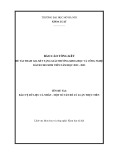
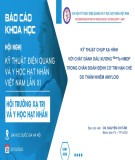

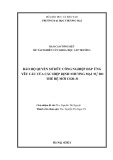
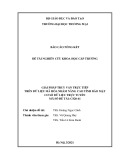
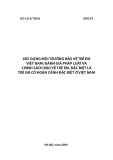

![Vaccine và ứng dụng: Bài tiểu luận [chuẩn SEO]](https://cdn.tailieu.vn/images/document/thumbnail/2016/20160519/3008140018/135x160/652005293.jpg)
